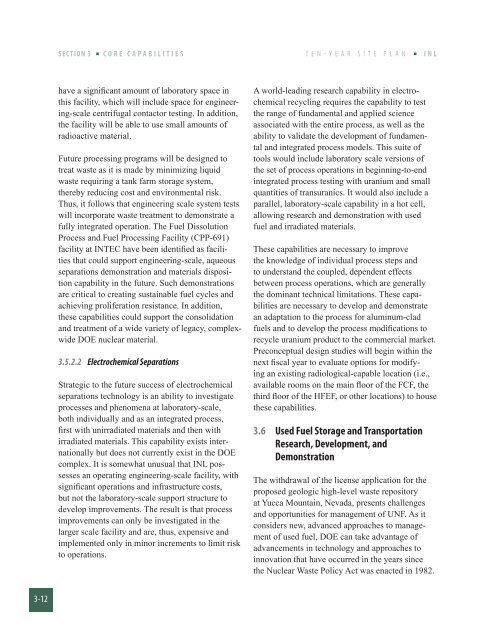2013-2022 TEN-YEAR SITE PLAN - Idaho National Laboratory
2013-2022 TEN-YEAR SITE PLAN - Idaho National Laboratory
2013-2022 TEN-YEAR SITE PLAN - Idaho National Laboratory
Create successful ePaper yourself
Turn your PDF publications into a flip-book with our unique Google optimized e-Paper software.
3-12<br />
SECTION 3 CORE CAPABILITIES<br />
have a significant amount of laboratory space in<br />
this facility, which will include space for engineering-scale<br />
centrifugal contactor testing. In addition,<br />
the facility will be able to use small amounts of<br />
radioactive material.<br />
Future processing programs will be designed to<br />
treat waste as it is made by minimizing liquid<br />
waste requiring a tank farm storage system,<br />
thereby reducing cost and environmental risk.<br />
Thus, it follows that engineering scale system tests<br />
will incorporate waste treatment to demonstrate a<br />
fully integrated operation. The Fuel Dissolution<br />
Process and Fuel Processing Facility (CPP-691)<br />
facility at INTEC have been identified as facilities<br />
that could support engineering-scale, aqueous<br />
separations demonstration and materials disposition<br />
capability in the future. Such demonstrations<br />
are critical to creating sustainable fuel cycles and<br />
achieving proliferation resistance. In addition,<br />
these capabilities could support the consolidation<br />
and treatment of a wide variety of legacy, complexwide<br />
DOE nuclear material.<br />
3.5.2.2 Electrochemical Separations<br />
Strategic to the future success of electrochemical<br />
separations technology is an ability to investigate<br />
processes and phenomena at laboratory-scale,<br />
both individually and as an integrated process,<br />
first with unirradiated materials and then with<br />
irradiated materials. This capability exists internationally<br />
but does not currently exist in the DOE<br />
complex. It is somewhat unusual that INL possesses<br />
an operating engineering-scale facility, with<br />
significant operations and infrastructure costs,<br />
but not the laboratory-scale support structure to<br />
develop improvements. The result is that process<br />
improvements can only be investigated in the<br />
larger scale facility and are, thus, expensive and<br />
implemented only in minor increments to limit risk<br />
to operations.<br />
T E N - Y E A R S I T E P L A N INL<br />
A world-leading research capability in electrochemical<br />
recycling requires the capability to test<br />
the range of fundamental and applied science<br />
associated with the entire process, as well as the<br />
ability to validate the development of fundamental<br />
and integrated process models. This suite of<br />
tools would include laboratory scale versions of<br />
the set of process operations in beginning-to-end<br />
integrated process testing with uranium and small<br />
quantities of transuranics. It would also include a<br />
parallel, laboratory-scale capability in a hot cell,<br />
allowing research and demonstration with used<br />
fuel and irradiated materials.<br />
These capabilities are necessary to improve<br />
the knowledge of individual process steps and<br />
to understand the coupled, dependent effects<br />
between process operations, which are generally<br />
the dominant technical limitations. These capabilities<br />
are necessary to develop and demonstrate<br />
an adaptation to the process for aluminum-clad<br />
fuels and to develop the process modifications to<br />
recycle uranium product to the commercial market.<br />
Preconceptual design studies will begin within the<br />
next fiscal year to evaluate options for modifying<br />
an existing radiological-capable location (i.e.,<br />
available rooms on the main floor of the FCF, the<br />
third floor of the HFEF, or other locations) to house<br />
these capabilities.<br />
3.6 Used Fuel Storage and Transportation<br />
Research, Development, and<br />
Demonstration<br />
The withdrawal of the license application for the<br />
proposed geologic high-level waste repository<br />
at Yucca Mountain, Nevada, presents challenges<br />
and opportunities for management of UNF. As it<br />
considers new, advanced approaches to management<br />
of used fuel, DOE can take advantage of<br />
advancements in technology and approaches to<br />
innovation that have occurred in the years since<br />
the Nuclear Waste Policy Act was enacted in 1982.

















